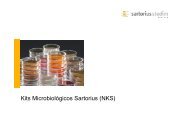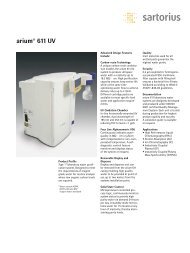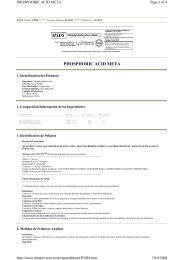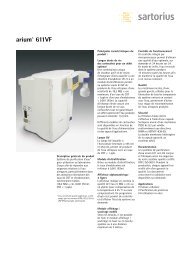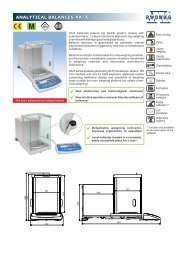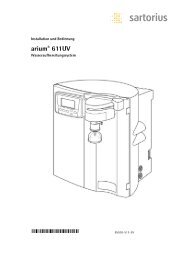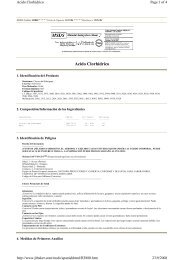Material Safety Data Sheet
Material Safety Data Sheet
Material Safety Data Sheet
Create successful ePaper yourself
Turn your PDF publications into a flip-book with our unique Google optimized e-Paper software.
http://fscimage.fishersci.com/msds/00140.htmPage 4 of 723/9/2008Evaporation Rate:5.6 (n-Butyl acetate=1)Viscosity: 0.32 cps @ 20 deg CBoiling Point: 56.5 deg CFreezing/Melting Point:-94 deg CDecomposition Temperature:Not available.Solubility: Soluble.Specific Gravity/Density:0.788 @ 25°CMolecular Formula:C3H6OMolecular Weight:58.08Section 10 - Stability and ReactivityChemical Stability: Stable at room temperature in closed containers under normal storage andhandling conditions.Conditions to Avoid: High temperatures, ignition sources, confined spaces.Incompatibilities with Other <strong>Material</strong>s: Strong oxidizing agents, strong reducing agents,strong bases, nitric acid, hexachloromelamine, sulfur dichloride, potassium tert-butoxide.Hazardous Decomposition Products: Carbon monoxide, carbon dioxide.Hazardous Polymerization: Will not occur.Section 11 - Toxicological InformationRTECS#:CAS# 67-64-1: AL3150000LD50/LC50:CAS# 67-64-1:Dermal, guinea pig: LD50 = >9400 uL/kg;Draize test, rabbit, eye: 20 mg Severe;Draize test, rabbit, eye: 20 mg/24H Moderate;Draize test, rabbit, eye: 10 uL Mild;Draize test, rabbit, skin: 500 mg/24H Mild;Inhalation, mouse: LC50 = 44 gm/m3/4H;Inhalation, rat: LC50 = 50100 mg/m3/8H;Oral, mouse: LD50 = 3 gm/kg;Oral, rabbit: LD50 = 5340 mg/kg;Oral, rat: LD50 = 5800 mg/kg;.Carcinogenicity:CAS# 67-64-1: Not listed by ACGIH, IARC, NTP, or CA Prop 65.Epidemiology: In a series of studies, no statistically significant differences in causes of death orclinical laboratory results were observed in 948 employees exposed to up to 1070 ppm acetoneover 23 years.Teratogenicity: Animal studies have only shown harmful effects in the offspring of animalsexposed to doses which also produced significant maternal toxicity.Reproductive Effects: During the Stewart et al. study, four adult female volunteers wereexposed 7.5 hours to acetone vapor at a nominal concentration of 1000 ppm.Three of the fourwomen experienced premature menstrual periods which were attributed to the acetoneexposure.Mutagenicity: Sex chromosome loss and nondisjunction(Yeast - Saccharomyces cerevisiae) =47600 ppm; Cytogenetic analysis(Rodent - hamster Fibroblast)= 40 gm/L.Neurotoxicity: No information foundOther Studies:




